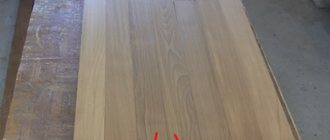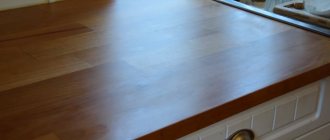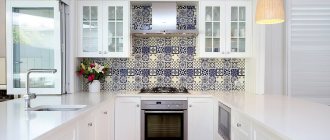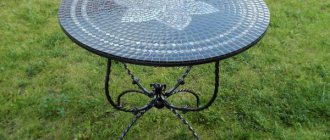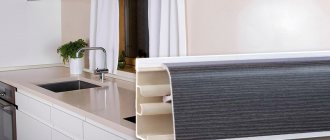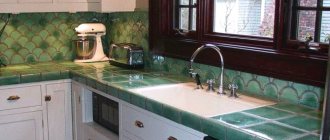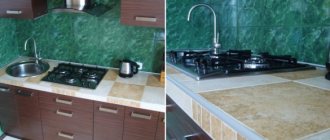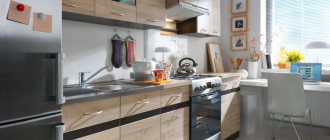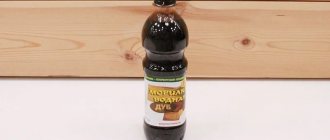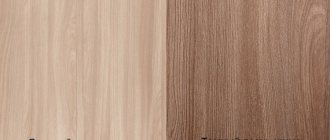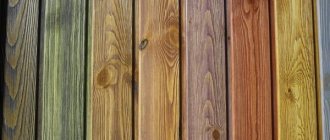Advantages and disadvantages of wooden countertops
Any surface made from one material or another has its positive and negative qualities. Before choosing wood for your kitchen countertop, you cannot miss the pros and cons of using this material for your kitchen countertops. The first include:
- long service life;
- beautiful appearance;
- naturalness;
- easy restoration.
You will avoid unpleasant consequences if you decide to make a countertop with your own hands.
Speaking about the disadvantages, they list:
- high cost;
- low resistance to water and temperature;
- capriciousness in care and operation.
But all these shortcomings can be easily corrected with proper care and the use of special protective agents in the form of oils, impregnations or varnishes. When talking about price, it is important to remember the durability of this material, and wood ages beautifully. A little restoration and it's like new again.
Consider the dimensions - the load on the kitchen table depends on this.
Oil, wax or varnish?
Caring for and proper use of a wooden countertop will extend its life.
A high-quality coating with good compounds will give a wooden tabletop a beautiful look and protect it from moisture and aggressive detergents.
In order for the tabletop to last longer and maintain its appearance, do not cut anything directly on the wood and do not test the surface for fire resistance and heat resistance.
How to cover a wooden tabletop so that it lasts as long as possible and at the same time remains beautiful?
- Oil, wax.
- Alkyd coatings.
- Water-dispersed compositions.
Depending on the coating, the same type of wood looks different: polyurethane gel, glossy varnish, wood oil
Ideally impregnated with oil, oil-wax. Oil, nourishing the wood structure, gives it water-repellent properties. When properly treated with good oil and wax, the countertop becomes resistant to household chemicals and detergents, which are often used for washing kitchen utensils.
The ideal option for protecting a wooden tabletop is a bio-impregnation based on natural vegetable oils and beeswax.
Apply the oil coating either with a brush or a rag evenly over the entire surface.
A special oil designed to impregnate wood that comes into contact with food will ensure environmentally friendly processing.
Oils for treating wooden countertops can be vegetable, synthetic or mineral
You can apply colored glaze, stain, and other water-dispersed coatings followed by application of varnish. The properties of the varnish used, its resistance to moisture, and multi-layer coating are important.
The varnish treatment option is better because the wood is coated with a protective layer, which is much stronger than oil protection.
A high-quality coating is carried out in several layers - two or three - regardless of the paint composition. Do not mix alkyd and acrylic coatings. Before covering the countertop with the base compound, it is important to select the appropriate primer.
Preparing a wooden table for varnishing
You can use a primer that matches the natural color of the wood, or a colored primer that matches the color of the varnish that will be used on the wood.
Advice!
For maximum durability, the coating should be renewed one year after application. It takes time for the product to “get used” to the surface at different temperatures. When exposed to external conditions, microcracks appear on the surface of the coatings, which are visually indistinguishable. Therefore, it will be useful to lightly sand the top layer and apply a new layer with the same composition.
Sand the surface and apply a layer of varnish along the wood grain
Beech wood before and after treatment: on the left – untreated beech, in the center – after treatment with white oil, on the right – oil varnish
The quality of the coating can be tested in the following way: apply a few drops of water to the countertop and observe how quickly they are absorbed. A good coating has excellent water-repellent properties.
Exposure to water can only be short-term - otherwise the wood will have to be sanded and waxed again
It is important to consider the drying time of the compositions; it can vary from several hours to several days. Natural oils and acrylic mixtures have a long drying period or accumulate strength gradually over time, so it is important to limit the use of the countertop during the drying period.
It is impossible to protect wood from scratches and mechanical influences with paints and oils, so there is only one way out - treat wooden countertops with the utmost care.
Wooden countertops are an excellent solution for modern kitchens
The slight carelessness of the wooden surface will give the kitchen...humanity. Isn't that what we value most? Humanity... Kitchen? Why not?
A place for wood can be found in a kitchen in any style, it is only important to approach the matter correctly
A wooden countertop in the kitchen is a beautiful and high-quality material that will decorate your kitchen
Basic principles and rules for gluing boards for table tops
Most wood countertops are made from individual pieces of wood using a variety of methods. The gluing option is quite expensive. The correct approach to manufacturing will make it possible to install it not only for a straight kitchen set, but also for a corner one. It consists of assembling a single layer from individual bars. The principle of fastening directly depends on further variation of the assembly. With further high load on the surface, the shields are connected to the parts or to each other with grooves that fit into each other.
There is no need to make the width of the tabletop more than 60 cm, and the thickness should not exceed 5 cm.
The next option is fastening with insert plywood. How to glue boards for a tabletop:
- inserted tenons, their diameter should be half the thickness of the bar, and their length should be 10 times the diameter;
- end connection using glue (the weakest);
- angular fastening at 45 degrees (increases strength and fastening area);
- joining “half-tree” using recesses for tightening locks (recesses are made from the ends of the boards);
- connecting boards along the entire length using wedges or tenons using glue (tenons are selected depending on the model of the tabletop - trapezoidal, flat, round or jagged);
- joining with inserted round tenons.
The easiest way is to join using wood glue and wooden nails.
Don't forget to treat the outer ends of the countertop.
Tree selection
When choosing a material, the purpose of the table on which the tabletop is mounted and its location are important.
The selection criteria are:
Expert opinion
Romanova Ksenia Petrovna
Interior design expert and fabric store manager
This indicator determines the ability of the material to withstand mechanical and thermal loads, as well as prevent moisture.
It is characterized by the ability to be treated with detergents and other sanitary and hygienic products.
It is characterized by the durability and hygiene of the material, as well as its ability to be restored and repaired.
To make a tabletop, a board with a thickness of at least 25.0 mm and a high degree of drying can be used. Its humidity should be no more than 12.0%.
The raw materials for the production of boards can be oak, cherry, walnut, teak, iroko, Siberian larch, linden, birch, spruce or pine.
In addition, solid wood, straight plank or furniture board, which are made from the above listed wood species, can be used for production.
Straight planken - a wooden board with sharp edges trimmed. Plankens come in straight, beveled and straight with grooves.
Furniture board is a natural material made from wooden blocks connected to each other by gluing.
Which tree to choose
The future tabletop must be strong and resistant to possible cracks, scratches, and abrasions during operation. The right type of wood is very important here. Cherry, cherry, walnut, oak or beech wood is suitable for long-term use.
Solid beech is widely used in the furniture industry, as products made from it are characterized by a high level of strength and durability.
The harder the rock, the more difficult it is to process, the stronger the reaction to changes in temperature and humidity, and the higher the cost. Tabletops made of wood are not only practical, but also beautiful. Shades and textures can transform any room, creating warmth and comfort. Regarding the disadvantages of suitable wood species, we can only talk about the high price.
Solid wood is considered to be a material that consists entirely of natural wood.
However, if you consider the number of years they can last, this minus quickly pays off. Pine as a starting material is the least expensive. This is due to the fact that its wood is too soft and short-lived. But if used correctly in a small family where the kitchen is not used 24/7, this option is also suitable.
Furniture made from solid pine has a light amber tint.
How to cover the tabletop
Having decided on the material, you need to understand that the optimal surface for the table will only be natural wood. In no case is veneer, MDF or chipboard used. Particular attention is paid to the age of the tree, its place of growth, and storage conditions.
Natural wood is the best option for making countertops.
It is important to know that a laminated wood surface will be more elastic and flexible than the same surface made from solid wood. The type of raw material is also important. Care methods must necessarily include treatment with special protective agents. What is the table covered with? It can be varnish, wax or oil.
There are three options for covering the table surface: varnish, wax and oil.
Practicality or durability
In order not to make a mistake in your choice, you should keep in mind some features of tree species. Harder ones, such as oak or beech, will last longer. However, their cost is much higher.
Hardwood furniture will last longer.
Among the democratic ones, pine, birch, ash or larch are perfect. Speaking about the latter, we should note a number of advantages. Its surface is quite dense and resistant to various types of damage. The presence of gum in the composition prevents the growth of fungi and mold, as well as rot, which is very important considering where it will be used. Larch is also capable of absorbing or releasing excess moisture.
Larch is also optimal for countertop material.
Oil, wax or varnish
Avoiding the harmful effects of water, temperature, acid and alkali will help extend the life of a wooden tabletop. Here the question immediately arises of how to cover a wooden tabletop so that it lasts a long time.
Among those available, processing using the following means is suitable:
- oil;
- wax;
- varnish
Surface treatment with oil, or rather its impregnation, is the optimal way to protect wooden products. It provides a kind of barrier that repels water from the surface. Oil absorbed into the top layer of wood will prevent it from getting wet when in contact with water. Oil compositions are not washed off, but require frequent use. At the moment, you can choose different compositions that match the color.
Oil protects wood from moisture.
Wax is a natural and environmentally friendly material. The effect of its use is similar to oil. But in addition to protecting against water, the wax coating also protects against minor mechanical impacts (scuffs and scratches). However, there are also disadvantages. A wax coating wears out quickly and requires updating and polishing more often than an oil coating. Before this, the old layer is cleaned off.
The wax coating requires regular updating.
Using varnish on a wooden tabletop is a radical method. It protects wood from water, minor mechanical damage, and exposure to ultraviolet radiation, while the structure of the tree itself does not change. The color of the surface remains the same, and a natural exchange of moisture also occurs, preventing the appearance of fungi and mold.
The varnish protects the surface from all contamination.
This coating also protects against temperature influences without flaking or cracking. To remove the varnish coating, the tabletop will have to be scraped.
Choice of design and construction
There are many variations to implement any ideas. But first of all, the main thing is not to overestimate your own capabilities and skills. It will be much more pleasant to make a tabletop that is simple in design, but of high quality, than to aim for something global, for which you do not have enough strength, time and skills. In addition, be sure to take into account the stylistic decision of the kitchen, the dimensions and weight of the finished product, the material for the base, and the complexity of the modification.
It is suitable for sophisticated kitchen design. It will look especially impressive in a country house.
Important! Beginners in this business are recommended to start with simple options, minimizing mortise parts.
It is better not to use old wood, because... As a result of improper storage, it can be damaged by mold, mildew or bark beetle. And accordingly, the service life of the product will be short. The necessary design can be achieved using special tint products. This product will last much longer. The main point in the ideal completion of kitchen design is considered to be a countertop, in which all dimensions are correctly calculated. And they directly depend on the size of the kitchen and methods of operation.
A wooden surface always looks presentable and expensive.
Drawing up drawings
Before you start work, be sure to have a drawing at hand. To compile it, you need to take measurements of the piece of the kitchen where the countertop is supposed to be installed. The drawing must contain the parameters necessary for manufacturing:
- length (the distance to walls or equipment is also indicated);
- width (the distance from the wall should be 5 mm);
- height (the height of the owners serves as a guide);
- thickness (depending on the material and load on the countertop);
- location of sockets;
- communications;
- technological holes.
The durability of the countertop depends on the manufacturing method. Solid wood is more prone to warping than glued wood.
The process of making your own wood countertops for the kitchen
Production technologies are being improved by introducing composite materials that complement natural ones. Wood is always in demand, so if you want to add a table to your interior, you should take advantage of the ability of designers to turn disadvantages into advantages.
Materials, tools
An excellent option is a panel tabletop, which can be made from boards if they are thicker than 1.5 cm. An additional 2 cm board is required to create a prefabricated mass. The length of the workpieces exceeds the length of the table surface by 10 cm (5 cm on each side). Cross members and a side are also used. Plywood is used for assembly. Work can be carried out on any table, supplemented with a thrust board and 4 cm guide bars.
Materials and tools:
- drill, drill bits (1 and 5 mm);
- 2 hammers: epoxy and steel;
- wood glue;
- nails made of copper (bronze), wooden nails 3-5 mm in the shape of a cone;
- 4 clamps;
- square;
- breakdown;
- pieces of plywood as linings.
Assembling the base - joinery panel
The first board of the shield must be attached with clamps to the guide crossbars. The transverse lining is lubricated with adhesive and fixed with nails (you cannot finish it off, then you need to bite off the caps or remove them). The second board (and subsequent ones) is driven in with a tongue and groove (from the corner, using an epoxy hammer).
When using beams, they must be pressed onto glue using clamps one at a time (each gluing takes 24 hours to dry). Clamps can be replaced with 80 cm studs with wing nuts. There are other methods: a wedge on a comb beam and a sawn beam compacted with wedges. The last 2 options are primitive and not convenient. To complete the assembly at once, a large number of tubes are required.
Salary - manufacturing nuances
The frames are made from hardwood. They give the tabletop a finished look and protect your hands from hangnails. If a typesetting board is used to make the surface of the table, the edging is cut out on the solid surface using a milling cutter. You can also make a special beam and nail it with bronze nails. To increase strength, additional glue is used.
Sanding the cut edge of a wooden tabletop
The wood surface must be sanded. If you don't have a grinder, use sandpaper.
How to paint a tabletop
Varnish is most often used. Tsapona is applied in several layers, it can be sanded, it dries quickly, but emits an unpleasant odor. Acrylic and oil based varnishes are applied with a sprayer in 2-3 layers. The second and third layers are applied after the previous one has completely dried.
Necessary tools and consumables
Tools, materials and supplies vary from modification of the selected surface and wood. The following are commonly used:
- stationery;
- drawing;
- wood (boards, bars or slab);
- consumables (nails, screws);
- hammer;
- pliers;
- milling machine;
- sandpaper of different grains;
- plane, jointer or grinder;
- paints and varnishes;
- wood antiseptic;
- brushes
This list may be changed as necessary.
Step-by-step manufacturing guides
Table surfaces can be assembled in a variety of ways. Some are made from solid wood, others are prefabricated, glued or paneled from wooden plates. When everything you need is at hand, there is a drawing, a step-by-step action plan, you can begin making the countertop. Considering the sources, there are several manufacturing options.
The tabletop, as a working surface, is subject to strict conditions. It must have an aesthetic appearance, resistance to damage, heat and water.
From pine
Pine has a very beautiful pattern on the wood, however, being a soft species, it is more susceptible to cracks, cuts and scratches, i.e. mechanical damage. Lumber is inspected and selected only without flaws. There should be no knots, damage by pests or wormholes, or deformations resulting from improper drying and storage.
Hot dishes leave stains, so the product must be varnished.
Initially, it is necessary to properly process all the boards, creating a perfectly smooth surface without splinters. Next, a drill is used to make holes for dowels at each side end. The same distance of 10 cm should be left between them. In the outer boards, holes are drilled only on one side. Dust and chips formed as a result of work must be carefully removed.
At the next stage, all boards must be glued with special wood glue or PVA. Then connect the boards together using wooden dowels placed in the prepared holes.
Important! When gluing a pine tabletop with your own hands, it is recommended to direct the pattern in different directions. This increases the strength of the product and reduces the risk of deformation.
After complete drying, cut off excess glue with a construction knife and sand the surface with a grinding machine. Apply a special antiseptic to the finished shield. Cover with varnish or wax with added varnish. This method allows you to create countertops of any shape and variation.
From bars
The whole process is a sequence of the following manipulations:
- cut bars of the required length in the required quantity;
- process the outer surface with a plane;
- cut grooves from the ends;
- cut slats to fit the width of the grooves;
- insert the slats into the groove, having previously lubricated it with wood glue;
- connect the bars by inserting slats into the free grooves of adjacent bars, lubricating them with glue;
- compress the structure with clamps.
When the layers of the constructed countertop have completely dried, its surface is carefully sanded, cleaned of dust and impregnated with antiseptics. Next, you need to cover it with protective agents (varnish, wax or oil).
The table, made entirely of 100 mm thick timber, is massive, solid and looks impressive.
From oak
Solid oak is usually used as sawn wood. This type of countertop manufacturing is called slap. It is very popular among beginners in carpentry, because... quite simple. The most important thing here is to choose a good and correct cut. The best option is wood without flaws in the form of long cracks, approximately the same thickness. In addition, the material should be properly dried and leveled.
Important! When choosing thickness, you need to remember about grinding, which will reduce it.
Initially, you need to remove the bark from the cut with a scraper or chisel. The next step is to level the surface and sand it. Cover with protective agents, stain, varnish (moisture resistant) in several layers.
It is important not to rush, but to let each coating dry thoroughly.
Characteristics of kitchen countertops
With the help of a correctly selected wooden countertop, it is quite easy to refine the interior design of the kitchen space, giving the interior environmental friendliness, solidity and prestige. Despite the fact that modules made from solid wood today are somewhat inferior in terms of practicality to some synthetic materials (primarily due to the need for regular maintenance), its attractiveness is a fundamental factor in sustainable demand.
The main characteristics that a high-quality kitchen countertop must meet:
- resistance to moisture;
- resistance to temperature changes, thermal influences;
- ability to withstand mechanical stress;
- ease of care, cleaning, cleaning;
- resistance to absorption of dirt, foreign odors, condensation, grease;
- high aesthetic and ergonomic qualities.
Modern technologies involve the production of several types of solid wood countertops, which are classified according to two criteria: the type of wood used and the production method.
Articles on the topic (click to view)
- Metal kitchen rack for appliances
- Instructions for the electric stove “classic plus”
- How to choose an electric stove with 4 burners and an oven for the kitchen
- Sofa in the bay window for the kitchen
- Lighters for gas stoves
- Small enamel kitchen sink
- Electric Turk with automatic shut-off when boiling
Today, several types of wood, soft and hard varieties, are used for the production of countertops. Moreover , too hard rocks can dry out over time, which will lead to early deformations and the formation of visible cracks on the surface of the product.
And those that are too soft can quickly be pressed through during careless handling. The optimal varieties most available in our area are:
Today, two main technologies for manufacturing wooden countertops are used:
- Made from solid wood . These products are characterized by an excellent natural texture. Since the cost of such products is extremely high, they are usually used in expensive classic kitchen sets.
- Made from glued lamellas. It is a collection of perfectly processed and fitted strips of wood. Since different types of wood can be used in each layer, it is much easier to build a tabletop that is resistant to temperature influences and more durable than analogues made from solid wood. Only the aesthetics in this case may be lower, since it is difficult to match the lines of wood texture of different lamellas.
Advantages of oak and pine boards
These furniture products have the following advantages:
- Ease of manufacture and restoration . Having special skills and having the appropriate carpentry tools and equipment, you can give tabletops any shape, produce them in any configuration and size. They are also subject to multiple restoration procedures, varnishing, and painting.
- Ecological cleanliness . Natural wood is a natural material, therefore it is not capable of harming the environment, people and pets due to the absence of any harmful/dangerous emissions.
- Highest aesthetic qualities . Kitchen countertops, even those made from the most affordable types of wood, and subjected to minimal processing, always look much more advantageous in the kitchen than most alternative products.
- A huge selection of textures , colors, and wood processing methods will allow you to create a unique product that can become the highlight of a kitchen interior designed in any style.
- Elasticity. Wood is more resistant to minor mechanical impacts when compared, for example, with natural stone. Thanks to some shock-absorbing properties, the appearance of dents and chips on the working surface is eliminated during mild impacts.
- High wear resistance. Subject to the manufacturing technology of solid wood countertops, appropriate primary processing and proper operation, they can easily withstand high-temperature and moisture tests.
- Excellent ergonomic characteristics . Natural wood is pleasant to the touch and creates a feeling of warmth upon tactile contact due to its low thermal conductivity, in contrast to natural stone and metal.
Flaws
- The main negative factor preventing the increase in demand for solid wood kitchen worktops is their relatively high cost. But the price of other natural materials used in the production of such products may be even higher. Therefore, a more inexpensive alternative is countertops and kitchen backsplashes made of MDF or other wood-based material, veneered or painted.
- Since wood is a porous material, if the protective layer is damaged, it can easily absorb moisture, which will lead to its deformation. Therefore, it is necessary to monitor the condition of the protective coating and update it in a timely manner.
- Also, wood is not the most resistant material to high temperatures. Proper use of solid wood work surfaces involves the use of thermally insulated stands for hot pots and, in particular, frying pans.
- Another disadvantage of these products is their low scratch resistance. The protective varnish coating is easily damaged when cutting food. Therefore, it is highly recommended to use kitchen cutting boards.
Watch how to make a solid wood tabletop with your own hands. Video instruction:
Ways to decorate a product
When choosing a finishing option for a finished product, you should rely on the interior design of the kitchen. There are many ways to decorate:
- self-adhesive film;
- craquelure (creating an aging effect by applying a special varnish made from egg white or PVA glue);
- painting;
- decoupage (decorating the surface with various drawings, photographs or images prepared on special decoupage napkins);
- simple or intricate coloring;
But the tree itself has a beautiful, unique pattern, so applying protective coatings will not only emphasize the beauty of the material, but will also extend the service life of the product. Another option for decor when making countertops is to use different types of wood in gluing. This gives the tabletop a unique ornament and color palette.
Examples of handmade wooden countertops
There are many examples of handmade countertops. The following are examples of different types of bases.
- Table top made of slab;
- Tabletop made using corner joint method;
- A tabletop made by joining boards along the entire length.
Kitchen furniture is often made to order and has an irregular shape.
Wood in this case is the most pliable material. Based on your desires and your own abilities, you can make such an important kitchen detail as a countertop. Depending on the chosen option, you will need a little more or less skills, time, and costs. But regardless of this, the result obtained from such a creative process will exceed all investments.
Wooden countertops for the kitchen: advantages, disadvantages
The advantage of wood, which cannot be disputed, is environmental safety. The family can only benefit from installing wooden furniture.
Other advantages:
- solid appearance;
- pleasant sensations when touched;
- timeless relevance of interior fashion;
- neutrality (combination with any style);
- durability (with proper use);
- maintainability.
However, natural wood requires regular, careful care. During manufacturing, the material is treated with insect repellent. Resistance to moisture is increased by varnishing and oil impregnation.
Other cons:
- tendency to form dents, cuts, scratches (restoring the surface requires time and money);
- the need to select cleaning products (abrasive ones cause scratches);
- relatively heavy weight.
Natural wood is an expensive material. You can save money if you make wooden kitchen countertops with your own hands without purchasing new expensive materials.
